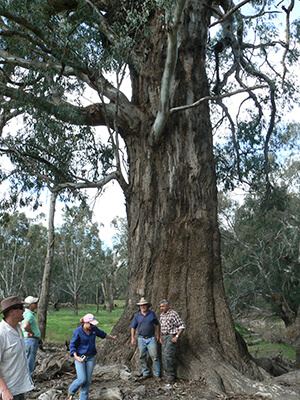The group brings together the local knowledge and expertise of interested community and government organisations to advise on the management of environmental water for sustaining the Lachlan’s floodplain and riverine systems and the ecosystem services they provide.
Chaired by Mal Carnegie, Projects Manager for the Lake Cowal Foundation, the group aims to achieve maximum environmental benefits from all sources of water, while minimising impacts on other catchment users.
'The Environmental Water Advisory Group is made up of agency staff and stakeholders who have a common desire to use the available water for the environment effectively and efficiently for maximum benefit,' Mr Carnegie said.
Recent successes
Recent successes include:
- Providing numerous refuge habitats for a wide range of water birds, including threatened species (blue-billed duck, freckled duck, brolga), and feeding sites for migratory and resident shorebirds under drought conditions in 2019–20.
- The Environmental Water Advisory Group's successful long-term partnership with the Ngiyampaa Nation to deliver cultural and ecological co-benefits in Booberoi Creek was recently celebrated in the Murray Darling Basin Authority (MDBA) Basin-wide Environmental Watering Strategy 2019 and in the 'Rivers, the veins of our Country' case studies of First Nations involvement in managing water for the environment in the Murray Darling Basin.
- Department of Climate Change, Energy, the Environment and Water with advice and on-ground assistance from EWAG members successfully managed the largest straw-necked ibis colonial bird breeding event on record for the Lachlan Catchment in the Booligal region in 2016. Monitoring by Department of Climate Change, Energy, the Environment and Water's Science Division in partnership with UNSW and the Commonwealth's Long Term Intervention Monitoring (LTIM) Project recorded over 100,000 individual nests using innovative drone technology.
- The Lachlan EWAG’s innovative management of Lake Brewster storage cells and inflow and outflow wetlands (in partnership with WaterNSW) led to markedly improved water quality for the environment and all lower Lachlan water users. For the first time since the Lake Brewster Water Efficiency Project was completed in 2010, aquatic plants or macrophytes were established in the outflow wetlands. These plants function like our kidneys, taking up nutrients from both the water column and substrate (reducing blue green algal loads), while providing a surface on which biofilms can develop, reducing wave intensity and stabilising the fine clay substrate.
- Department of Climate Change, Energy, the Environment and Water and WaterNSW with support from the Lachlan EWAG managed to completion one of the few successful inland Australian pelican breeding events during the 2016 flooding at Lake Brewster (about 8000 birds). This is one of the few sites in the Murray Darling Basin where pelicans breed in large numbers (more than 5000 nests) on a semi-regular basis.
- NSW Department of Climate Change, Energy, the Environment and Water, UNSW and WaterNSW have an ongoing research project to band Australian pelicans from Lake Brewster to learn more about their movements. The collaboration started with banding 66 juveniles from the successful breeding event in May 2017, and a further 77 birds following another success breeding event managed and monitored in conjunction with other EWAG members, including Lake Cowal Foundation.
Priorities
Mr Carnegie and environmental water managers believe the priorities for improving outcomes within the catchment are to:
- enhance opportunities for threatened and other native fish and waterbird recruitment in the Lachlan Regulated River Water Source
- use water for the environment to target specific outcomes for native plants and animals by providing the right amount of water at the right time for them to feed, breed and grow. It is a critical tool for supporting the health of rivers and wetlands, which in turn, supports the communities that rely on them
- protect and restore the Lachlan’s floodplain habitats, which are critical for many species to complete their lifecycles (e.g. spawning, recruitment and refugia) and for energising the food web
- continue to support the implementation of First Nation’s rights and aspirations in water management so as to improve the spiritual, cultural, natural, environmental, social and economic conditions of the Nation; and in doing so, enhance environmental watering outcomes via the mechanism of two-way learning
- implement key recommendations from the Evaluation of NSW Environmental Water Advisory Groups and capitalise on opportunities from the renewal of membership process to use local knowledge and strengthen and develop new cooperative relationships with stakeholders and delivery partners
- to inform progress towards achieving the objectives and targets in the Lachlan Long Term Water Plan (LTWP) through monitoring. Objectives include restoring the ecological characteristics and functions of iconic and nationally significant wetlands dependent on floodplain inundation and connectivity
- use the NSW-held environmental water portfolio to achieve the best environmental effect, through water delivery, the application of planned environmental water provisions in water sharing plans, carry over and complimentary measures, including land management and addressing constraints such as fish passage.
The Environmental Water Advisory Group advises on the use of water for the environment from a number of sources including the environmental water provisions of the Water Sharing Plan for the Lachlan Regulated River Water Source 2003, adaptive water held by the Department of Climate Change, Energy, the Environment and Water and allocations made available from entitlements held by the Commonwealth Environmental Water Holder.
Range of stakeholders
Group members represent a range of stakeholders including the Aboriginal community, Lachlan landholders and water users (including floodplain graziers, irrigators, stock and domestic users), the Lake Cowal Foundation, the Department of Climate Change, Energy, the Environment and Water (DCCEEW), the NSW Department of Primary Industries and Regional Development (DPIRD) Fisheries, Lachlan Valley Water, WaterNSW, the Murray Darling Basin Authority, the Commonwealth Environmental Water Holder (CEWH) and University of Canberra.

Landholders in the Lachlan valley inspect a Booberoi big tree